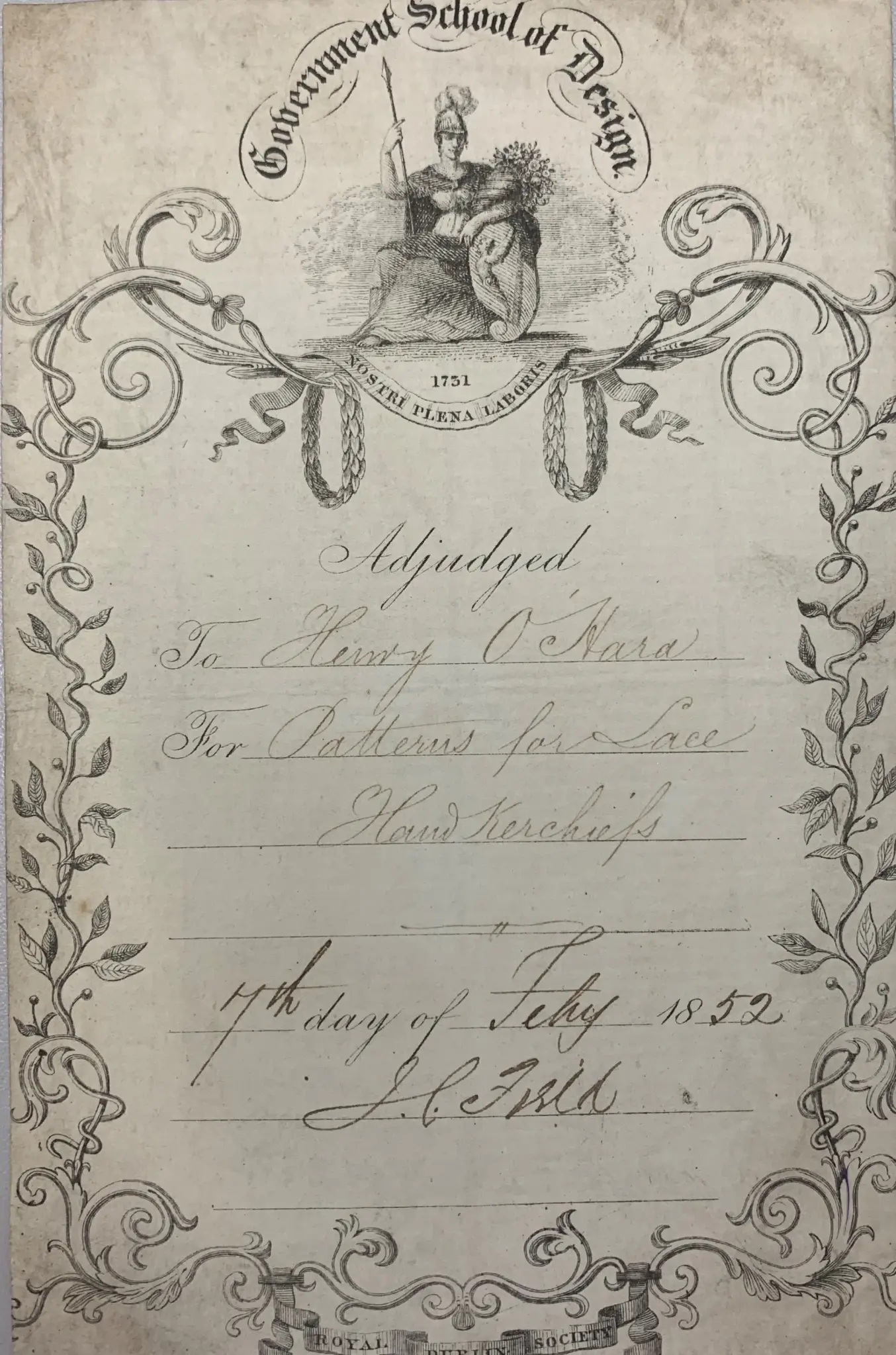Bookplate Stories: Christina Frances Hicks

This post is part of a series of stories written by Liz West, Fellow in Ephemera Studies, about the Amoret Tanner bookplate collection. Read more here
·
Story one
Aiming High
♥
This plate was created for Christina Frances Hicks (1885-1935), the daughter of Edward Hicks, the Bishop of Lincoln. The Latin inscription, visible on a rung of the ladder, is ‘Alta Pete’ – Aim at high things. The child in the picture is doing just that, ignoring the pile of toys at the foot of the ladder and stretching out to take a very serious and heavy looking book off the shelf above her. Christina’s father had a forward-looking stance on many subjects, including pacifism, feminism and social reform. A supporter of women’s suffrage he campaigned, without success, to have the injunction to ‘obey’ removed from the Church of England Marriage Service.1
It is easy to imagine, therefore, that Christina’s bookplate was commissioned by her father, keen to inspire her from an early age. Certainly, with his encouragement, she became one of the first women to study at Oxford, winning a scholarship to Somerville College. She married EV Knox, the poet, satirist and editor of Punch, and her daughter, Penelope Fitzgerald was to become one of the leading novelists of the Twentieth-century. Sadly, Christina did not live long enough to witness her daughter’s success; she died when Penelope was eleven.
Bookplate 120mm x 90mm AT Collection
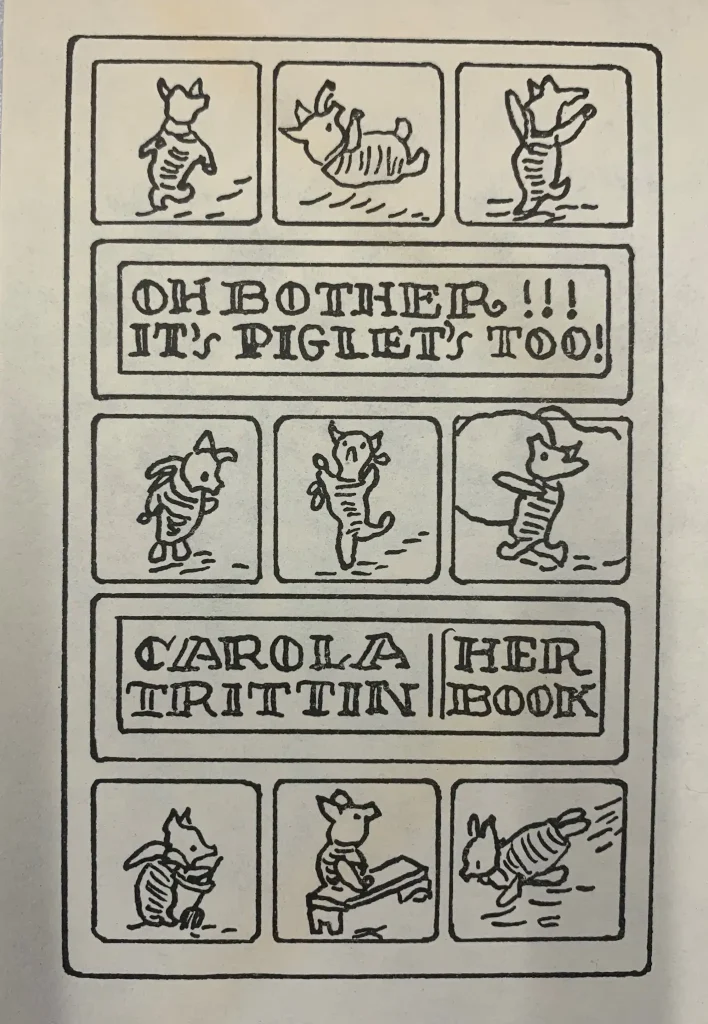 We don’t have a date for Carola Trittin’s bookplate, so we don’t know whether it was used by her as a child or an adult (she was born in 1906 so would have been 10 when AA Milne’s Winnie the Pooh was first published). However, it is pleasing to discover that she became a chemist in a particularly appropriate field. She was technical director of the Ward Paper Company in Merrill, Wisconsin, prior to becoming a member of faculty in the Paper Technology Department at Western Michigan College of Education.
We don’t have a date for Carola Trittin’s bookplate, so we don’t know whether it was used by her as a child or an adult (she was born in 1906 so would have been 10 when AA Milne’s Winnie the Pooh was first published). However, it is pleasing to discover that she became a chemist in a particularly appropriate field. She was technical director of the Ward Paper Company in Merrill, Wisconsin, prior to becoming a member of faculty in the Paper Technology Department at Western Michigan College of Education.
·
Story two
Children’s Illustrators
♥♥
Many of our best loved children’s book illustrators also designed bookplates. Two examples which feature in our collection are Kate Greenaway (1846-1901) and Edward Ardizzone (1900-1979). Greenaway’s paintings were reproduced by chromoxylography, a method by which the colours were printed from hand-engraved wood blocks by the firm of Edmund Evans. Amongst the bookplates she designed is a set for the Locker-Lampson family, pictured here, all of which feature the family motto: ‘Fear God and Fear Nothing’. Frederick Locker was a writer, poet and keen book collector, who counted Dickens, Thackeray, George Eliot, Ruskin, the Brownings, Tennyson and Trollope amongst his acquaintances. He added his wife’s maiden name to the family surname in 1885. Locker-Lampson was a mentor of Greenaway, and she designed bookplates for Frederick, his wife, Hannah Jane, and children.
Bookplate 90mm x 70mm Artist: Kate Greenaway AT Collection Bookplate 80mm x 60mm Artist: Kate Greenaway AT Collection Bookplate 80mm x 70mm Artist: Kate Greenaway AT Collection

Bookplate 100mm x 70mm Artist: Kate Greenaway AT Collection

Although best remembered for his work as a book illustrator and war artist, Ardizzone created several bookplates for friends and colleagues, as well as at the request of organisations such as the Mary Ward College of Education, pictured here. He also designed a bookplate for the Library Association Youth Libraries Section in 1957, for a fee of 10 guineas, and a copy of the signed original artwork was given to Seven Stories, National Centre for Children’s Books, in 2014 as an addition to its collection of original Ardizzone artwork.
Bookplate 100mm x 70mm Artist: Edward Ardizzone AT Collection Bookplate 140mm x 100mm Artist: Edward Ardizzone AT Collection Bookplate 120mm x 90mm Artist: Edward Ardizzone AT Collection
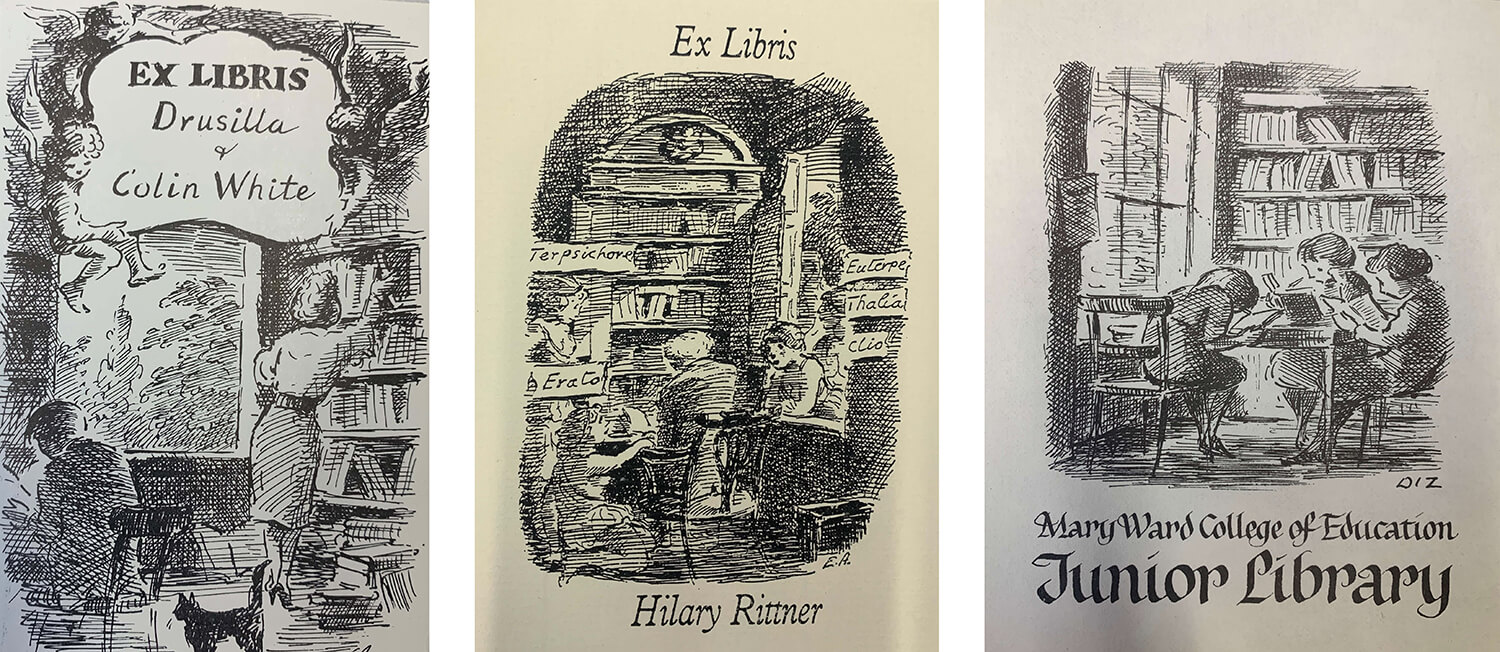
Hilary Rittner, the owner of the centre bookplate depicted here, is a bookish person herself, as Ardizzone’s illustration implies. An advertisement placed in The Spectator in 2005 advertises her services as a book sleuth: ‘Books searched for, often found.’
·
Story three
Prize Plates
♥♥♥
Bookplate 130mm x 90mm AT Collection
A particularly rich variation on the theme of children’s bookplates is the school prize label. These artefacts tell us interesting things about historical education systems, and what was deemed prizeworthy in terms of subject-matter and levels of attainment. Biggar High School, featured here, listed Agriculture alongside more standard subjects of Literature, Science, Art, Music and Commerce.
Prizes were awarded not only for academic subjects, but for effort (step forward Master E Snow), and for a range of quite niche skills: Henry O’Hara’s prize for ‘patterns for lace handkerchiefs’ brings to mind Nigel Molesworth’s fictional nemesis, Grabber:
‘head of the skool, captane of everything and winer of the mrs joyful prize for rafia work’.
Geoffrey Willans and Ronald Searle, Down With Skool
Bookplate 110mm x 100mm AT Collection Bookplate 110mm x 70mm AT Collection
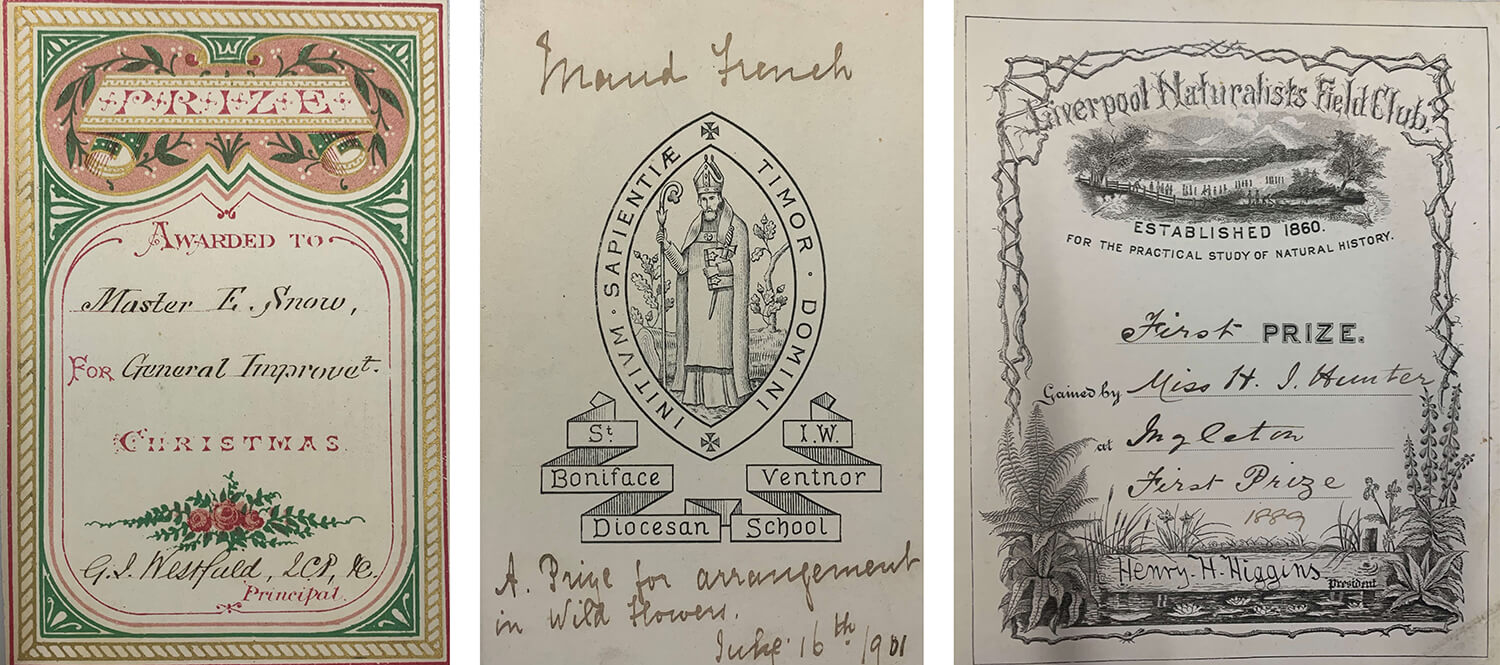
Bookplate 130mm x 110mm AT Collection Bookplate 150mm x 100mm 1852 AT Collection
Bookplate 80mm x 60mm AT Collection
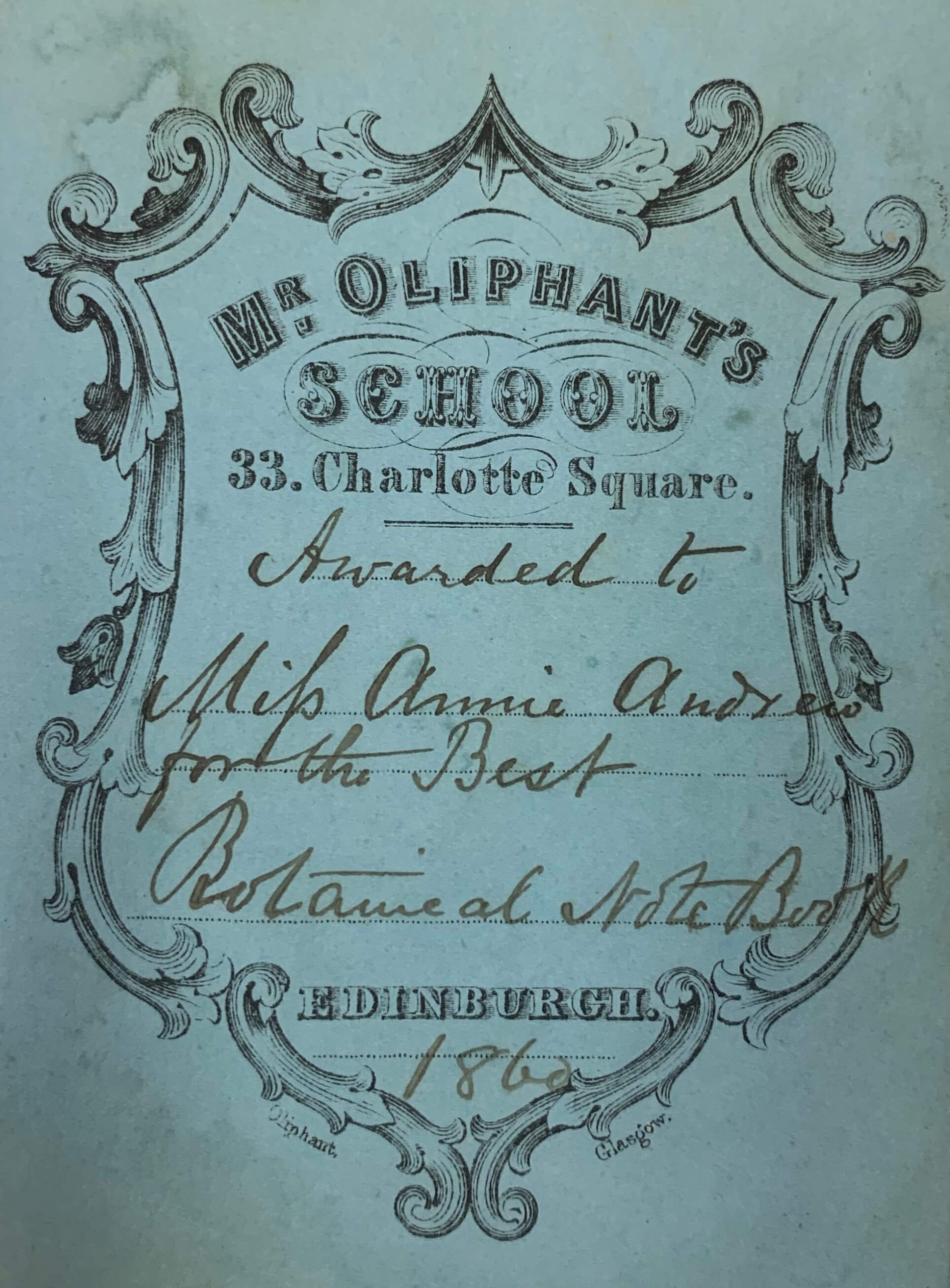 In Edinburgh, Annie Andrews, a pupil at Mr Oliphant’s School, won an award for best botanical notebook. Originally set up by Thomas Oliphant as a teacher-training college in 1842, it became a fee-paying school for girls four years later. Again, it recalls fictional establishments of the period, not least Thackeray’s Miss Pinkerton’s Academy for Young Ladies, alma mater of Becky Sharp, heroine of Vanity Fair, published in 1847.
In Edinburgh, Annie Andrews, a pupil at Mr Oliphant’s School, won an award for best botanical notebook. Originally set up by Thomas Oliphant as a teacher-training college in 1842, it became a fee-paying school for girls four years later. Again, it recalls fictional establishments of the period, not least Thackeray’s Miss Pinkerton’s Academy for Young Ladies, alma mater of Becky Sharp, heroine of Vanity Fair, published in 1847.
·
Story four
Youthful collectors
♥♥♥♥
In Children’s Bookplates, written in 1902, American author, lecturer, librarian, and publisher, Zella Allen Dixson, gave a compelling argument for bookplate collecting as a beneficial hobby for the young:
‘To have a book plate is to be personally interested with every other plate and to seek information of all connected with it. To know even a few plates well is to have learned indirectly many things not generally know in history, literature, travel, biography, heraldry, and fine art. A little child who owns a good bookplate and has been made to understand all about it, the race to which it belongs, the ideas it embodies, has not only gained a personal acquaintance with illustrious lives that will overshadow and influence its own, but will enter the race of life better equipped and will be better educated than a little child who has not had this formal introduction into the world of the past.’
[l-r: Bookplates 90mm x 70mm; 110mm x 80mm; 100mm x 80mm; 130mm x 100mm; AT Collection]
Amoret Tanner, who donated this treasure trove of bookplates to the Centre for Ephemera Studies, began collecting bookplates as a child, guided by her father, an avid ex libris enthusiast who pursued his interest across the world, corresponding with Japanese artists and acquiring their work as well as commissioning examples for his family. Some examples of Amoret’s bookplates are pictured here.
Bookplate 100mm x 80mm Artist: Yumimaro Ohmari AT Collection Bookplate 80mm x 100mm Artist: Bruce Inverarity AT Collection Bookplate 110mm x 110mm Artist: Bruce

Inverarity AT Collection Bookplate 100mm x 80mm AT Collection

 Amoret’s leather-bound album of bookplates was brought together by her father as a way of recording family history. It includes the first bookplate her mother, Joyce Shields acquired as a girl.
Amoret’s leather-bound album of bookplates was brought together by her father as a way of recording family history. It includes the first bookplate her mother, Joyce Shields acquired as a girl.
AT Album page, AT Collection
As Amoret explains, ‘I took it as a matter of course that one had a bookplate but an adult had to paste them into my books.’ Handwritten notes accompany many of the bookplates, and give information about their origin and creator.
Below: AT Album double-page spread, AT Collection

AT Album double-page spread, AT Collection
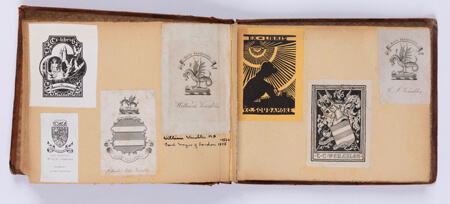
The collection is a wonderful example of a hobby that crossed generations, and which continues to provide interest for a wider audience. Amoret’s involvement with the collection did not end with its donation to our Centre: she is still very involved, and makes weekly visits as a volunteer, generously donating her expertise and experience along with her wonderful bookplates and related ephemera.
Bookplate 90mm x 40mm 1790 AT Collection
1Hermione Lee, Penelope Fitzgerald: A Life

